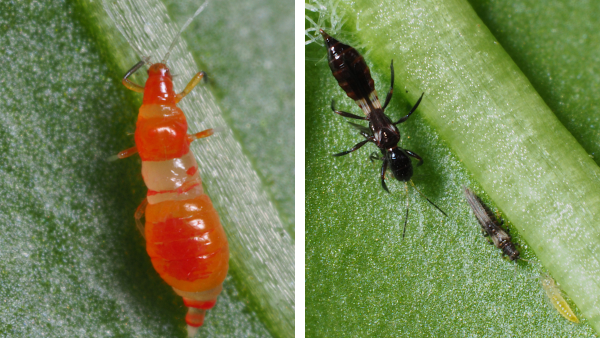Meet Frankie, a new solution for growers battling foliar thrips
Thursday, July 18, 2024
A chance backyard discovery by one of our entomologists has led us to develop Franklinothrips vespiformis, a new ally for Australian growers in the difficult battle to control leaf-dwelling thrips.
Australian growers never talk about thrips and their role in ensuring a healthy crop. There is no denying it, pest thrips cause them big problems. However, there are beneficial thrips as well, quietly doing their work in the background. Occasionally these beneficial thrips make a big impact. For example, in late summer, the predatory Six-Spotted Thrip (Scolothrips sexmaculatus) often helps growers to control Two-Spotted Mite infestations in some broadacre, fruit tree, and protected crops. Predatory thrips can feed on spider mites, aphids, other thrips, moth eggs and even small caterpillars. The use of predatory thrips for the biological control of thrips has been investigated for decades but few are commercially available due to the availability of many biological control agents that are easier to rear en masse.
In 2022, while tending his potted plants at home, Biological Services Consultant Adam Billsborough noticed an ant-like insect feeding on the other thrips. Adam is a qualified entomologist and identified it as the native predatory thrip Franklinothrips vespiformis. He developed a small colony of the predatory thrips at home and learned from their feeding habits. Adam alerted Biological Services’ directors James Altmann and Lachlan Chilman about his discovery.
“We are fortunate to have IPM consultants of Adam’s calibre in our team,” says Lachlan Chilman. “Adam’s entomology qualifications and his innate curiosity enabled this discovery.” This beneficial thrips quickly got the nickname “Frankie”.
F. vespiformis occurs in the tropical and subtropical regions of the world, including Australia. It is unique in several aspects. It is much larger than a typical thrips (2.5-3mm long) and looks like an ant or wasp. The larvae and pupae are bright red. The larvae pupate on the leaf surface inside silk cocoons and the female has pronounced ant-like behaviours. They complete most of their lifecycle on the foliage of the host plant. F. vespiformis feeds on all thrips life stages, as well as spider mites and small arthropods. They can survive on pollen.

Adam’s discovery was the first step in the journey of developing Frankie into a commercial product. To confirm and expand on Adam’s discovery, large numbers of Frankie were needed for commercial trials. This task fell on Maricel Malonzo, Head of Research and Development at Biological Services’ Western Australian Insectary. Maricel developed a unique mass-rearing system for Frankie in cooperation with Biobest that has also just released F. vespiformis as a commercial product overseas.
The discovery and development of Frankie as a commercial product for Australian growers comes at an opportune time. Foliar thrips are usually nuisance pests in ornamentals and some horticulture crops but become significant pests when conditions are ideal. Chilli Thrips (Scirtothrips dorsalis) cause alarm globally due to their ability to cause significant damage during the early stages of crop development and the difficulty controlling it with the chemical and biological means currently available. Chilli Thrips were first detected in Western Australia more than 20 years ago and have caused major problems for horticulture and ornamental crops over the past four years. They are very difficult to control because their lifecycle is different from the other thrips. Chilli Thrips complete their lifecycle on the foliage, reach high numbers very quickly, and damage the young shoots and foliage of the plant long before any flowers develop.
Biological Services is at the forefront of optimising biological control options for Chilli Thrips control in Australia. Our initial trials show high levels of Neoseiulus cucumeris are needed to reduce Chilli Thrips numbers in strawberries when supplied as loose material or in slow-release sachets. We expect better control could be possible when combining it with Frankie.
“There is still a lot of work to be done about the future role of Frankie in dealing with the current Chilli Thrips challenge,” says James Altmann. “But we are optimistic about Frankie’s future, especially in perennial crops like blueberries and certain ornamentals and flowers.”
Frankie also feeds on other thrips such as Western Flower Thrips, making it a potent addition to thrips control programs that already rely on predatory mites (N. cucumeris and Typhlodromips montdorensis) and Orius tantillus. It performs well in ornamentals and capsicums according to overseas experiences. Frankie could be used in combination with the parasitic wasp Thripobius javae to better manage the greenhouse thrips (Heliothrips haemorrhoidalis), a notoriously difficult to control foliar thrip pest of broadleaf greenhouse plants, many types of ornamentals, and field and tree crops.
In our recent trials in medicinal cannabis, Frankie has given excellent control of Banded Greenhouse Thrips (Hercinothrips femoralis). Frankie remains active in the crop several months after the last release. Based on these findings, Frankie could be used to control other economically important foliar thrip pests present in Australia: Poinsettia Thrips (Echinothrips americanus), Taiwanese Thrips (Thrips parvispinus), Banana Rust Thrips (Chaetanaphothrips leeuweni) and Orchid Thrips (C. orchidii).
“This is an exciting development for Australia,” says Stephanus Malherbe, IPM Product Specialist at Biological Services. “I am convinced we have the solutions for many of our pest and disease problems right here in Australia, provided someone discovers and develops it.”
We are busy with trials to optimise the use of Frankie in integrated pest management programs for Australian conditions. Frankie is available, please contact our Loxton office to place an order.
For more information or to order, please contact our Loxton Head Office on 08 8584 6977 or email, or email Stephanus Malherbe, our dedicated IPM Product Specialist.





